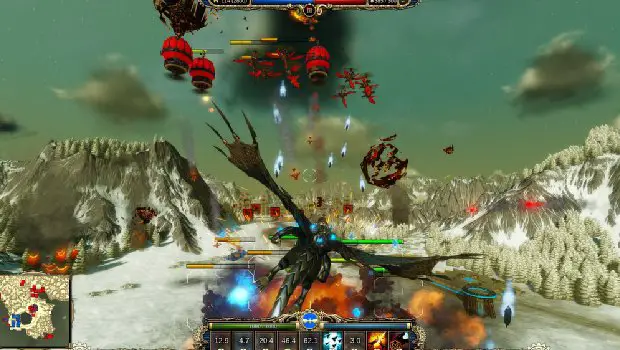
Larian Studios’ Divinity: Dragon Commander is a pretty aggressive game by any reasonable measure, developed with the aim of mixing turn-based, turn-based strategy with smaller-scale, real-time ‘army versus army’ combat. On top of this you have a campaign where political decisions impact the player’s strategic resources, while the ability to turn into a humongous fire-breathing and army-burning dragon adds a third-person action twist to the realtime fun. That’s quite a mix of genres, but Divinity: Dragon Commander manages to combine them reasonably well, and tell an interesting – if strange – story in the process. At the end of the day it manages to stand out as a unique and fun jack-of-all-trades strategy game, marred only by some hit-or-miss decisions in its policymaking portions, a seemingly dead-on-arrival multiplayer community, and the fact that it’s too busy being solidly good at too many things to be downright amazing at any of them in particular. For people who live fantasy-world strategy games looking for something new, and who don’t mind some soap-boxing in their games, Divinity: Dragon Commander is a game worth a serious look.
If you’ve seen my past reviews, you know that storyline tends to be rank rather low on my list of priorities – I care about well-executed gameplay more than anything else when it comes to my video game analysis. It’s to Larian Studios’ credit, then, that I found not just the general storyline of Divinity: Dragon Commander to be engaging, but also the general world it’s set in. You play as the bastard son of a once-mighty Emperor, who managed to forge a united kingdom out of diverse lands, employing good old-fashioned conquest to achieve victory and bring peace. Eventually, having fallen in love with a dragoness-turned-human – your character’s mother – he became distracted from his duties, turning far too soft for his own good. Before long the dragoness was murdered, as was the Emperor himself – done in by his own children, who then proceeded to fight with each other over the pieces of the now-shattered empire. Some powerful allies have decided to throw their lot in with you, the half-dragon offspring of the Emperor-dragoness coupling, believing you to be the key to restoring the empire to its proper glory. The fact that your character can turn into a humongous fire-breathing dragon probably has something to do with their confidence.[singlepic id=15219 w=320 h=240 float=right]
With the stage set for a good, long war, Divinity: Dragon Commander proceeds to introduce you to the various aspects of gameplay you’ll have to master. Originally developed to be far more of a board game than it ultimately turned out to be, the game’s highest level of strategic challenge comes in the form of a Risk-style map featuring various territories you (or your opponents) can take over and secure to acquire resources, fortify with troops, or use as a staging ground for combat. You’ll expand over the various territories, able to pay gold to build a single building in each territory you pick up – and these buildings grant one of a variety of passive bonuses, from increased gold production per turn, to additional research points to spend on upgrading your unit options or your dragon powers, to granting you strategic cards that can be used to give you an advantage either on the board game map or in combat. While the realtime combat and the political/investment decision-making are valuable in their own right, it’s this level of gameplay that manages to be the most important overall – if you fail to intelligently acquire and hold territory, you will soon find yourself in a situation you really can’t hope to win. In fact, you can even choose to skip over a considerable share of the actual realtime action and largely focus on the board game strategy – and when the calculated odds of the enemy winning are a mere 1%, chances are you’ll find yourself doing exactly that to save yourself some time.[singlepic id=15222 w=320 h=240 float=left]
Which isn’t to say you’ll always want to skip over the realtime strategy aspects of Divinity: Dragon Commander. The gameplay on offer in these portions is surprisingly fun, if simplified compared to more focused games in the RTS genre. There are no resources to mine or gather, and therefore no peons to micro-manage in this phase of the game. Instead, you simply let your population resources naturally accrue over time, sped up only by building recruitment centers at various pre-specified building points, which you can then spend on building units to send at your enemy. You can only build forces you’ve previously researched, which further streamlines the entire affair, and you’ll continuously build forces over the course of the conflict (though you and your opponent will also start out with the equivalent of the armies you had stationed in the region before the combat started – which means if you overwhelm your enemy to begin with, you can just storm right over and stomp them into the dirt for a fast, easy win.) The maps tend to be on the small side, even with the mix of land, sea and air units at your disposal, and the resulting conflict is a bit easier to manage than in most games. The simplicity is a good thing, since this mode is where the ‘Dragon Commander’ aspect of the game really comes into focus – and what sets Divinity: Dragon Commander apart from many other contenders in the strategy genre.
See, before you start any realtime conflict, you’re given the option to use various cards which will affect the fight’s outcome (granting you additional units, or crippling your enemy’s units, for example), along with the ability to either choose a general to lead your armies (granting your armies further bonuses at the cost of some gold), or to lead the army yourself. Choosing the last option allows you to spend resources to become a huge, damage-spewing dragon. At this point your control over your units is a bit more restricted (though not entirely lost) as you shift to a third-person camera view, flying your dragon around the battlefield to lay waste to the opposing forces. And I do mean lay waste – this dragon-form is not a mere hero unit, but a creature capable of literally, and easily, turning the tide of any conflict in your army’s favor. You can still be damaged while in this form, but what’s really important is the AE damage and general support you can throw down for your armies – slaughtering troopers and warlocks en masse, making early conflicts almost too easy to win as a result. While the controls take a bit used to, this is honestly and truly quite a change from the usual realtime strategy experience – and fun besides. How can it NOT be fun? You’re a huge dragon spewing fire and acid and more onto whole armies – that’s a hard thing to screw up, and Larian Studios pulls it off well.[singlepic id=15214 w=320 h=240 float=right]
Neither your dragon nor your armies are static in their options either. You can use research points acquired from the strategic turn-based part of the game to spend on a variety of units and unit-upgrades, as well as an equally large array of dragon powers, both passive and active. These are both separated into 4 tiers of increasingly costly options, and part of the strategy is picking which unlocks to spend research points on given the conflicts you’re likely to face. This all takes place in the massive floating battleship that serves as your HQ – and which also happens to be where the story portions of Divinity: Dragon Commander plays out, and where political decisions must be made. After all, as the game reminds you, you’re not only a warrior and a general – you’re also a leader, and your subjects continue to struggle to survive while the war rages on around them. When you’re not speaking with your generals and other story-centric characters, you’ll be giving a literal thumbs up or thumbs down to a variety of policy questions, each of which will impact your gameplay in the form of various boons or detriments to your production and economic statistics, as well as shifting support from the racial factions.
Now, this happens to be the most well-polished aspect of the entire game by a longshot – and initially seeing this decision-making in action is what caught my interest in the game in the first place. The characters you run into have beautiful graphics that are well-animated, set up against equally gorgeous and evocative backgrounds within your massive floating battleship. Most of the major decisions center around a council of five ‘racial leaders’ representing the non-human factions in the game, and they manage to be graphically impressive, splendidly voice-acted… and a collection of obnoxious caricatures that will either delight you, or quickly get on your nerves. Divinity: Dragon Commander’s political decisions are, for the most part, based on real-life political disputes – while there may be a fantasy spin here and there, at the end of the day you’ll be deciding whether or not to (say) pass universal health for your kingdom, not arguing over just how many magical jellybeans to allot the gold-farting nymphs from the rare and haunted fizzywhizzle tree or the like. It wouldn’t be very dramatic if all of the council tended to agree, of course, so on any given topic you’ll have the characters splitting up and giving you their views on the matter.[singlepic id=15220 w=320 h=240 float=left]
Which means the game does its share of editorializing. Yes, the characters disagree with each other, but in most of the truly hot-button issues the game strongly hints at which answer is The Right One, and which characters are therefore taking The Wrong Side. You can generally count on the obnoxiously religious undead faction leader to be a heartless, sanctimonious jackass no matter what he’s commenting on, with the greedy profit-loving dwarf being a close runner up in that department. Meanwhile, the elf and lizard faction leaders fill out the other end of the spectrum, with their main detriments being too passionate (the elf) and too lecturing (the lizard), despite more often than not being portrayed as The Right Side. The imp serves as the fifth wheel here, largely being the irreverent comic relief compared to the other four. Chances are, if you typically agree with the lizard and the elf in the main, you’re not going to find this annoying. In fact, you may well be delighted. Otherwise, unless you’re just politically apathetic altogether, odds are you’ll end up resenting some of these interactions. I can’t call this a clear knock against the game – this is about as subjective as it gets, and game developers are free to present whatever views they like – but consider it a warning if you find yourself marching out of lockstep with others on hot button political issues. On the upside, you can make whatever decisions you like and still generally end up with some kind of vaguely appropriate overall-boon for your efforts – plus, you get to make the other side furious for deciding whichever way you did, and that may actually be entertaining! Just be sure to watch the overall racial opinion of your reign, as the territories you take over are each inhabited by one of the aforementioned races – and if they have a low opinion of you, it will make it harder to wage war in their lands.
[singlepic id=15215 w=320 h=240 float=right]But the political decisions, mixed and subjective bag as they are, don’t really detract from the overall success of Divinity: Dragon Commander. In fact, if the game can be said to have any failing, it’s that it tries to do so many different things (turn-based strategy, realtime strategy, interactive RPG-style scenes) that it was practically destined to be, at best, merely above average in everything it’s trying to do, or else a tremendously flawed game. It’s no small accomplishment that Larian Studios managed to achieve the better possibility: all the various parts of the game are quite good, and fit together beautifully – but none of them are truly amazing. Not exactly the biggest flaw in the world, that one. A more noteworthy flaw, however, would be in the game’s multiplayer community. Put simply, there isn’t much of one: multiplayer matches are pretty hard to come by, and I don’t see that improving in the near future. The game does offer skirmish options for those who don’t necessarily want to dive into the campaign anew, and the lan/online multiplayer may be taken advantage of by groups of gamers who tend to play with each other. Just don’t pick this up hoping to graduate from the campaign to a major and thriving online community – for all practical purposes, consider this to be a singleplayer game first and foremost. And a damn good one at that.
You can pick up Divinity: Dragon Commander right now for $39.99 in the Steam store, with 10% off if you own Divinity II: Developer’s Cut.
Victor Grunn has been a gamer since the days of single-button joysticks and the Atari 800XL. When not lamenting the loss of the Ultima series or setting people on fire in Team Fortress 2, he's an aspiring indie game developer and freelance writer.

See below for our list of partners and affiliates:

























